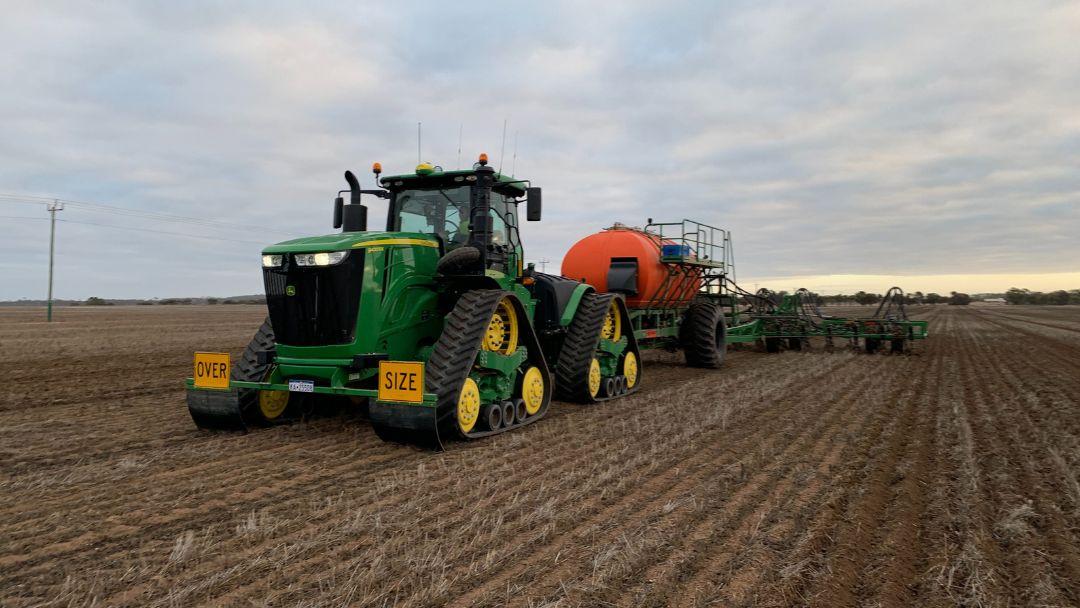In his recent International Fertiliser Society (IFS) paper, ACTFA board member Dr Dio Antille and his colleagues have done an excellent job of bringing together research information on the effects of field traffic from across the world. It won’t surprise ACTFA members to hear that uncontrolled traffic of heavy equipment has resulted in significant negative impacts on the sustainability and productivity of cropping in virtually every major cropping region. Here we follow their collation of the research results, adding information as required in an attempt to provide a straightforward explanation of compaction effects.
Compaction is the increase in soil bulk density: it is the cumulative effect of loads that are greater than the bearing capacity of the soil. These loads are commonly applied by field traffic. Compaction often occurs when soil is moist and weak, but it can also happen with heavy loads on soft dry soil. We sometimes see the evidence of this months later in the next crop, after a fully loaded chaser has made a beeline home, diagonally across a CTF paddock – the evidence only coming to light in the next crop.
The reverse process – decompaction – can be achieved rapidly by tillage, at a cost, but heavy equipment can produce compaction at depths where tillage is too expensive or impractical.
In some active shrink/swell soils natural decompaction can occur with wetting and drying on a timescale of years. For most soils however, decompaction occurs only slowly, through the activity of roots and soil biota, on a timescale of decades, so the traffic frequency in intensive cropping systems ensures that opportunities for natural amelioration are rare or non-existent. Similarly, the transient effect of cover crops ensures they are not, on their own, an effective, long-term ‘fix’ for soil compaction.
Compaction severity depends on the interacting effects of tyre inflation pressure, axle load and soil bearing capacity at the time of traffic. For any given soil and traffic situation, the extent of compaction is mainly determined by how the load is spread over the soil contact area. The compaction response varies with soil texture and moisture content, but these are rarely uniform down the profile. This means the depth and extent of compaction from any specific traffic event is extremely difficult to predict, although the practical effects are often evident in the field.
Traffic compaction effects on infiltration, runoff and water storage
Compaction reduces permeability to air and water, so it reduces infiltration. Because the larger soil pores are the weakest, they are the first to collapse under traffic loads. These are the ‘transmission’ or ‘drainage’ pores, responsible for water movement down the soil profile. Research shows that 10% and 20% increases in soil bulk density can reduce infiltration rates by 50% and 75%, respectively, in an uncompacted medium-textured soil. As an example, annual wheeling by a 6 t tractor reduced average total infiltration by 36% on a heavy Vertisol in Queensland, which will concurrently reduce plant available water.
Reduced infiltration also increases run-off – by up to 55% in the example above – and this often implies a direct loss of productivity because it means less water available for the crop or soil storage. Run-off can also result in movement of dissolved soil nutrients, transport of soil amendments, and soil particles carrying adsorbed nutrients – all of which are pollutants in the water courses. Major soil loss can be disastrous, but measurements of run-off nutrient content suggest that common levels of run-off can often represent a significant financial loss. It is another loss that is exacerbated by soil compaction.
We all know that residue and surface protection is the first line of defence against run-off and erosion, but uncompacted soil beneath can be almost as important. This has been demonstrated in modelling used to predict run-off from field plots in the Fitzroy basin of Queensland under no-tillage, minimum tillage and conventional tillage operating in both controlled, partial controlled (partially matched machinery), and non-controlled traffic mode. Simulations using 50 years of local climate data showed the impact of each of these systems on average annual soil loss (Figure 1, reproduced from the IFS paper).

Figure 1: Average annual soil loss from cropping under different tillage/traffic systems in the Fitzroy basin (The boxes represent range of the mean, the broken lines denote the min and max values, and individual points represent the outliers corresponding to years when high intensity rainfall occurred at vulnerable times (modified from Owens et al., 2019).
Another major effect of compaction is the reduction in the ability of the soil to store water in plant available form. In simple terms, compaction reduces soil pore size, and smaller pores hold moisture more tightly, so compaction reduces the “plant available water capacity” (PAWC). PAWC is important for all crops – winter crops that depend on moisture stored from summer rainfall, rainfed crops in any season with deficient rainfall, and irrigated crops where PAWC influences the frequency of irrigation.

Figure 2: Compaction effects on plant available water capacity (PAWC) in different soil types including medium- (sandy loam, loam, silty loam) and heavy-textured (clay loam, clay) soils (after Ngo-Cong et al. 2021).
The impact of compaction on PAWC is soil type dependent, and has been demonstrated by modelling, the results of which are illustrated in Figure 2 (reproduced from IFS paper). The soil type labels are unfamiliar in Australia, but by way of example, Grenada is a deep loamy, rather uniform and free-draining wind-blown soil in which compaction has a limited impact on PAWC. By comparison, Wilcox series is a Vertisol (60% clay) similar to those found in southern Queensland, where PAWC is rapidly reduced by compaction.
As noted earlier, annual wheeling by a 6 t tractor increased soil bulk density in a Queensland Vertisol by 15%, reduced infiltration rate by 36%, increased peak run-off by 55% and reduced PAWC by 10%. Modern field machinery is heavier by factors of 2-5, although improvements in tyre technology mean that tyre pressures have not increased to the same extent. Recent work in Queensland showed traffic by a 33 t cotton picker increased soil bulk density by ~13%, and reducing tyre pressure by 20-50% below recommended values limited the bulk density increase to 6%. This shows the potential of recently-developed “IF” and “VF” tyres that can be operated at substantially lower pressures than conventional tyres, so they’re likely to be less damaging to soil.
Notwithstanding the improvements in tyre technology, the best way to avoid soil compaction is to not drive on it in the first place, which is the foundation of CTF.
A second article based on the IFS paper will look at the effect of traffic compaction on soil processes in a future newsletter.
References
Antille, D.L., Misiewicz, P.A., Galambošová, J., Chamen, W.C.T., Tullberg, J.N. (2024). Traffic management systems for improved soil sustainability and nitrogen-use efficiency. Proceedings of the International Fertiliser Society, 899. ISBN 978-0-85310-536-7.
Ngo-Cong, D., Antille, D.L., van Genuchten, M.T., Nguyen, H.Q., Tekeste, M.Z., Baillie, C.P., Godwin, R.J. (2021). A modeling framework to quantify the effects of compaction on soil water retention and infiltration. Soil Science Society of America Journal, 85(6): 1931-1945. https://doi.org/10.1002/saj2.20328.
Owens, J., Silburn, M., Antille, D. (2019). The potential of controlled traffic farming to mitigate water quality impacts in the Great Barrier Reef catchments. In: Proceedings of the 3rd International CTF Conference. Australian Controlled Traffic Farming Association (ACTFA), 12-14 Feb. 2019, Federation University, Ballarat, VIC, Australia. Available at: https://www.actfa.net/actfa-conferences/2019-conference/.

